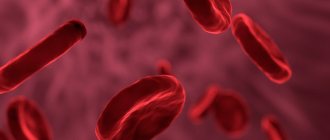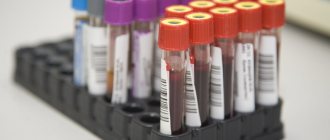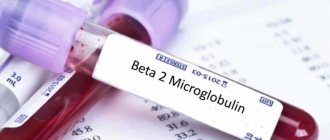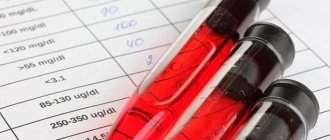Description:
Lactate dehydrogenase (LDH) exists in body tissues in the form of a tetramer: two monomers, H and M, can combine in different ratios to form the five known LDH isoenzymes. The enzyme catalyzes the reaction of converting pyruvic acid into lactic acid with the participation of NADH, as well as the reverse reaction. This reaction is the final stage of the anaerobic mechanism of glucose oxidation:
pyruvate + NADH + H+ ↔ L-lactate + NAD+
In some pathological conditions, an increase in LDH activity is observed, for example, with acute liver damage, with damage to skeletal muscles and kidneys, with megaloblastic and hemolytic anemia. In lymphoma, high plasma LDH activity predicts a poor prognosis. There is a relationship between enzyme activity and tumor volume, so sequential measurements of LDH activity levels make it possible to evaluate the effectiveness of therapy.
In both cardiac muscle and erythrocytes, LDH is represented mainly by LDH isoenzymes (H4). The isoenzyme exhibits much greater catalytic activity towards α-hydroxybutyrate than lactate (compared to other isoenzymes), therefore, when measuring LDH activity, this substrate is used. The second name of the LDH isoenzyme is α-hydroxybutyrate dehydrogenase (HBD).
Determining the level of activity of LDH isoenzymes is important in cases of suspected myocardial infarction and in the diagnosis of hemolytic crisis in sickle cell anemia.
LDH, Lactate dehydrogenase
Lactate dehydrogenase is an intracellular glycolytic zinc-containing enzyme that accelerates the final conversion of glucose.
LDH is localized in the cytoplasm of cells and is contained in almost all tissues and organs of the human body. The highest concentration of LDH is in the liver, kidneys, heart, pancreas, skeletal muscles, and blood cells (erythrocytes contain 100 times more LDH than blood serum). The level of the enzyme in a child’s body is higher than in an adult’s (the enzyme exhibits especially high activity in the body of newborn children). As children grow and mature, LDH levels gradually decrease. The concentration of lactate dehydrogenase in the female body is slightly lower than in the male body.
LDH is not a homogeneous enzyme. It is divided into five isoenzymes that have different molecular structures and are localized in different tissues and organs. A representative of any of them consists of a combination of four peptide chains - M and H. Under the influence of an electric field, the isoenzymes move at different speeds. The gradation from fast to slower movement looks like this: LDH-1, LDH-2, LDH-3, LDH-4, LDH-5.
The predominant isoform of the enzyme “dictates” the main way in which glucose will be oxidized. There are two options:
- aerobic (with the presence of oxygen), with oxidation to carbon dioxide and water;
- anaerobic (without oxygen), with oxidation to lactic acid.
This difference is due to the fact that each of the LDH isoforms has a characteristic degree of affinity with pyruvic acid.
The largest amounts of LDH-1 are found in the heart muscle, red blood cells, platelets and the renal cortex (the molecule consists of 4 identical H units).
Red blood cells, platelets, and kidneys also contain a significant amount of LDH-2.
Of the 5 isoenzymes, the predominant concentrations of LDH-3 and LDH-4 are characterized by the lungs, pancreas and thyroid gland, spleen, lymphocytes, and adrenal glands.
In addition, LDH-4 is contained in granulocytes, the placenta, male germ cells and, to a lesser extent, the liver.
The LDH-5 isoform (MMMM chain) is contained in skeletal muscles (it also contains LDH-4 and LDH-3, but their activity is lower than LDH-5) and the liver.
Normally, blood serum contains a small amount of LDH isoenzymes, which come there from renewing cells. The concentration of total LDH studied in this test is determined as the sum of the concentrations of all five isoenzymes. As the activity of LDH isoforms decreases, it is determined as follows: LDH-2 > LDH-1 > LDH-3 > LDH-4 > LDH-5.
Tissue damage results in the release of excess LDH into the serum, and therefore this test is used to determine the presence of tissue damage. The indicator is not specific - it cannot accurately determine the disease, however, in combination with other indicators, the test result allows you to diagnose:
- pulmonary infarction;
- muscular dystrophy;
- hemolytic anemia.
Testing LDH concentration is an auxiliary test in the diagnosis of myocardial infarction. Previously, studies of creatine kinase and aspartate aminotransferase (AST) levels were widely used to confirm pathology. However, the level of these enzymes during the process of treatment and restoration of the myocardium returns to normal values twice as quickly as the level of LDH. Therefore, studying the concentration of lactate dehydrogenase makes it possible to track the dynamics of the process at later stages of the disease.
Currently, to confirm the diagnosis of myocardial infarction, troponin testing, which is a more specific indicator of damage to the heart muscle, is more often performed. However, monitoring changes in LDH concentrations also allows one to monitor the progression of the disease. Its level begins to increase 12-24 hours after the onset of a painful attack and reaches peak levels after 24-48 hours. LDH activity remains high up to 10 days. It is directly dependent on the size of the myocardial lesion, and the speed of normalization depends on how quickly the heart muscle recovers. In addition, LDH activity is an identifier of true myocardial infarction and allows it to be distinguished from angina attacks with similar pain symptoms. During angina pectoris, LDH activity does not change, but during infarction, total LDH activity increases significantly.
An increase in the level of lactate dehydrogenase 1-2 days after a painful attack in the chest against the background of normal AST levels is an indicator of pulmonary infarction.
Studying the level of LDH in muscle pathologies allows us to identify the nature of the disease:
- enzyme activity remains normal if the cause of muscle dysfunction is neurogenic (caused by disruptions in the nervous system) diseases;
- the concentration of lactate dehydrogenase increases if muscle damage is caused by dysfunction of the endocrine glands or diseases characterized by metabolic disorders.
The development of malignant tumors can serve as an impetus for increasing the activity of lactate dehydrogenase. If the treatment used is effective, then the level of the enzyme decreases, so this testing can be used to monitor the condition of a cancer patient over time.
The reasons for increased LDH levels can be not only pathological, but also physiological. The latter, in particular, include pregnancy, the neonatal period, excessive physical activity, and the presence of a prosthetic heart valve.
Using different research methods may show different levels of the enzyme. Therefore, when determining an indicator over time, it is advisable to undergo examination in one laboratory.
Determination of the activity of LDH fractions by inactivation with urea
Principle
It consists in inhibiting the activity of the LDH-5 isoenzyme by urea by almost 100%.
Normal values
| Serum | (inhibition by urea) | 25-36% of total activity |
| (cellulose acetate electrophoresis) | LDH-1 | 19‑29% of total activity |
| LDH-2 | 23-37% of total activity | |
| LDH-3 | 17-25% of total activity | |
| LDH-4 | 8-17% of total activity | |
| LDH-5 | 8-18% of total activity |
Influencing factors
Narcotic analgesics and other painkillers, ethanol, dicoumarin overestimate the results of the study. Hemolysis must be avoided, since the enzyme activity in erythrocytes is higher than in serum. Oxalates and urea inhibit the enzyme.
Clinical and diagnostic value
All diseases that occur with cell destruction are accompanied by a sharp increase in LDH activity in the blood serum. An increase in the overall activity of the enzyme is found in diseases such as myocardial infarction, necrotic kidney damage, hepatitis, pancreatitis, inflammation and infarction of the lung, tumors of various locations, injuries, muscle dystrophy and atrophy, hemolytic anemia and physiological jaundice of newborns, lymphogranulomatosis, leukemia. During myocardial infarction, the beginning of an increase in enzyme activity in the blood serum is observed at 8-10 hours from the moment of the attack, the maximum increase occurs at 24-48 hours, often 15-20 times higher than normal. Increased LDH activity persists up to 10–12 days from the onset of the disease. The degree of increase in enzyme activity does not always correlate with the size of the damage to the heart muscle and can only be an indicative factor for predicting the outcome of the disease. In patients with angina pectoris, the enzyme activity does not change, which allows the test to be used for differential diagnosis within 2-3 days after a heart attack.
The presence of organ specificity of enzymes makes it possible to use the study of their activity for the purpose of topical diagnosis.
General activity and isoenzyme spectrum of lactate dehydrogenase in blood serum in certain diseases
| Disease | Total LDH activity | Isoenzymes | ||||
| LDH-1 | LDH-2 | LDH-3 | LDH-4 | LDH-5 | ||
| Myocardial infarction | ++ | + | + | |||
| Lung diseases | + | + | + | |||
| Viral hepatitis | + | + | + | |||
| Toxic hepatitis | + | + | + | |||
| Cirrhosis of the liver | + | + | + | |||
| Myeloid leukemia | ++ | + | + | |||
| Granulocytosis | ++ | + | + | |||
| Platelet destruction (embolism, blood transfusion) | + | + | + | + | ||
| Pancreatitis | + | + | + | |||
| Megaloblastic anemia | +++ | + | + | |||
| Hemolytic anemia | +++ | + | + | |||
| Kidney diseases | ++ | + | + | |||
| Myopathy | ++ | + | + | |||
In case of liver diseases, serum after incubation at 56°C loses about 50% of its activity, at 65°C - up to 90%. In case of cardiac lesions, inactivation at 56°C reaches 10%, at 65°C - about 60%. The activity of the urea-stable fraction in liver diseases decreases to 20% of the total; myocardial infarction is accompanied by an increase of over 40% in the activity of this fraction.
0
Features of using LDH-5
The equipment is intended for universal use from the first stubble hulling to subsequent pre-sowing preparation after hulling or plowing. When combined with a powerful traction device, the plougher tills the soil at a speed of 15 km per hour. This is considered a guarantee that the vegetation in the upper part of the soil will be closed on time after harvesting.
The equipment is made from high-grade raw materials, which allows for a simpler and more robust design, characterized by compactness and versatility with a minimum number of adjustment and lubrication points. The high pressing force of each disc, together with the cutting contour, allows you to obtain the necessary penetration into heavy and dry soils.
Functionality and profitability of equipment
The hydroficated disk huller LDG-5 is a highly efficient development of Ukrainian production. Performs surface treatment of soil to a depth of up to 15 cm.
It is used when processing soil for agricultural purposes after the main harvest, in fields where there is a huge amount of vegetation. It is successfully used for pre-sowing treatment, which improves the quality of plowing. Effectively handles fallow areas.
The use of technology improves the quality of the soil, eliminates erosion and weathering, and enhances exchange activities. The disk huller marked 5 operates with soil of different densities.
It effectively loosens it and is successfully used in conditions of high humidity. The device cuts off the roots of weeds, crushes decaying remains, and forms mulch.
During operation, the equipment mixes it with soil to the depth and width of the treatment. It makes the relief of the treated areas even, breaks up blocks, and eliminates insect larvae throughout the entire depth of influence. Using this technique, the soil is saturated with moisture, ensuring its preservation. The quality of the land and its fertility are improving.
Design and technical features of the equipment
The LDG-5 25 huller is a structurally productive and practical development. Allows you to get high performance and long life. The device is able to work efficiently even in abnormal conditions. Effective components are made of high-quality, wear-resistant materials.
They are located in four separate sections, at an angle to the base being processed. And one section of the ceiling. This design characteristic allows you to obtain the quality of continuous processing, without gaps. The device is connected to the hydraulic system of the tractor. Easily transforms from a moving position to a working position.
We recommend: What is a Lemken huller?
Main advantages of PPL 5 25:
- A variety of areas of use with high productivity.
- Low cost of use.
- Simple design with a minimum number of adjustment points.
- Large disc seats with reliable bearings that do not require maintenance.
- Possibility to choose among several types of rear rollers.
- The high pressing force of each disc allows you to obtain the required penetration into the soil.
- Low level of vegetation contamination.
View this post on Instagram
Publication from Belagromash-Service (@belagromash2020) May 22, 2021 at 9:36 PDT






